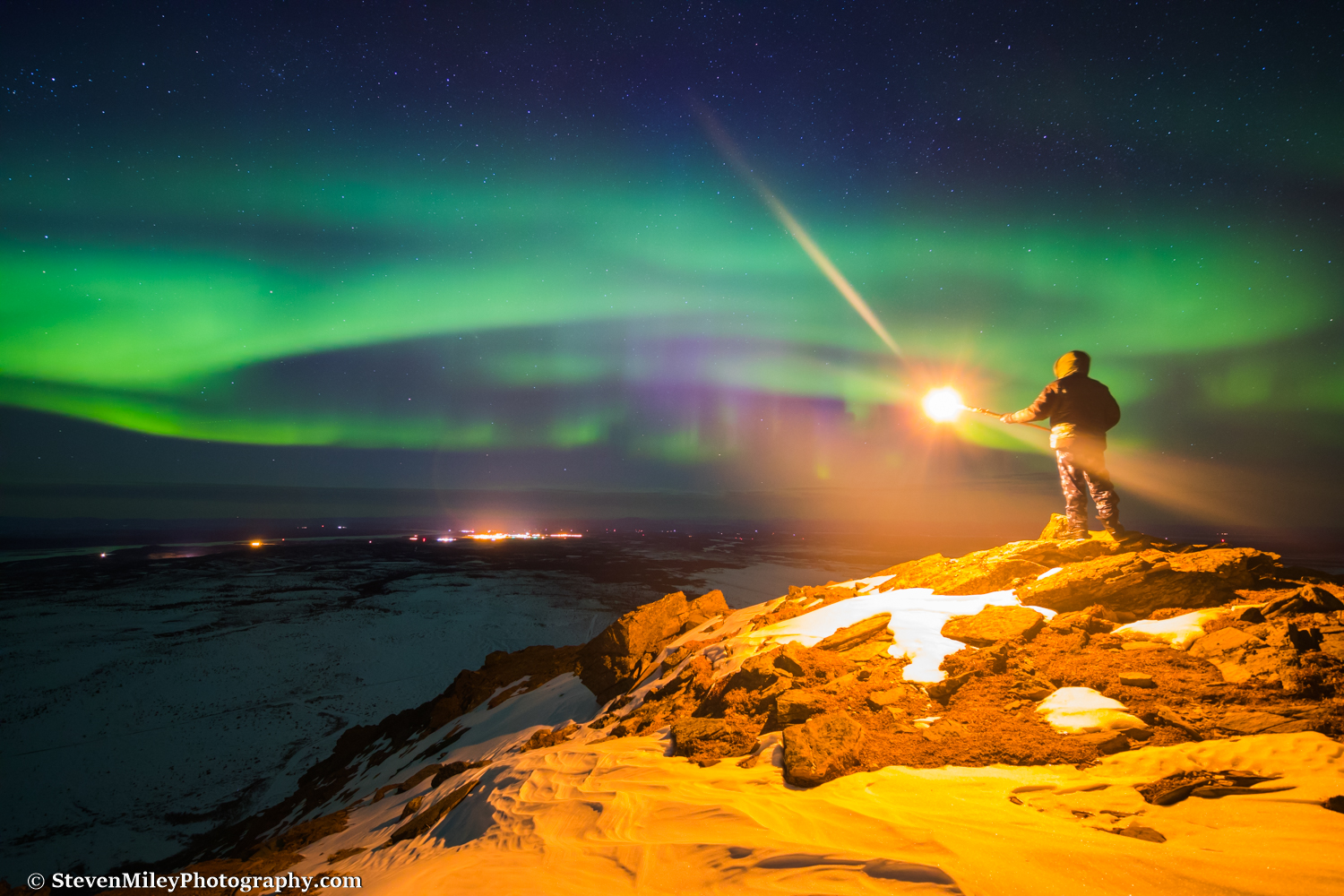The wind blows sparks from my torch as I watch the aurora borealis from the ridge of Donnelly Dome, south of Delta Junction.
Over the past four seasons, I've attempted to photogragh the aurora borealis from several natural settings away from Alaska's road system. I wouldn't refer to them all as "backcountry", but each location took significant effort to reach whether the aurora showed up or not. This fall I hoped to catch a good aurora show while camped near the base of Denali, but the overnight weather simply never cooperated. I spent a cold night winter camping with friends next to Black Rapids Glacier in mid-March but the great aurora show I was expecting showed up early and flared out by the time the sky darkened that night. Another attempted aurora photography adventure was thwarted in late March when I got my car stuck in the snow in my driveway.
With aurora photography season quickly coming to a close in Interior Alaska, I took advantage of a clear, moonless night in April with a good aurora forecast and set out to climb Donnelly Dome. Since there would be no moon to light up the landscape, I brought along supplies to make a rudimentary torch: a long wooden stick, an old t-shirt soaked in vegetable oil, some matches, and the toilet paper I always keep in my pack for kindling. The warm glow from a fire nicely complements the aurora on dark nights and adds a bit of life to an aurora image, and with the torch I would have the freedom to move around and create more adventurous shots than with a campfire.
Aurora borealis dancing during twilight above the lights of Fort Greely.
I arrived at the base of Donnelly Dome after 10 p.m. with the orange glow of nautical twilight still on the horizon. The aurora was already stirring so I paused for a few shots as I snowshoed up the trail toward the steep slope on the north side of the dome. After an hour or so I reached the summit ridge and found a steep rocky portion where I began waiting for the aurora to brighten again. The breeze was cold enough that I felt the need to put on my parka, and I threw on my polar bear pajama bottoms as a joke for anyone looking closely at my photographs.
View of Fort Greely and the Missile Defense Complex from Donnelly Dome prior to lighting the torch. Light pollution is noticeably reflecting off the snow over 10 miles away in this long exposure.
I prepared my camera gear and took a few test shots without the torch so I'd be ready when the aurora sparked up. The foreground appeared very dim and blended in too much with the flats below. Posing silhouetted on the ridge made the image more interesting, but it still didn't really pop. I waited for over an hour until the aurora finally showed signs of life, at which point I quickly lit the torch and began photographing.
Posing with the torch on the ridge of Donnelly Dome overlooking Fort Greely.
The torch burned brightly, completely outclassing my headlamp and making it difficult to prevent overexposing the foreground as I executed my shot looking towards Fort Greely. I used my camera's timer to capture images of me posing with the torch while trying to stay completely still in the breeze. It doesn't seem like a t-shirt and a little vegetable oil would burn very long but the torch lasted over 20 minutes, which allowed me to try several different compositions as the aurora shifted in the sky. For about 30 seconds the aurora went wild over the summit of Donnelly Dome in the opposite direction, but I didn't have enough time to reposition the tripod, change the timer settings and find a good spot to pose with the torch to capture the display. Oh well, it was still a cool sight.
After the torch burned out, so did the aurora. I made my way down in the dark and got back to town sometime after 4 a.m. These aurora images turned out to be my last of the season and I won't be taking any more until at least August. Hopefully, solar minimum will have passed by then and we'll see more frequent stunning aurora displays next winter!
For tips on creating aurora images like these, read my free Aurora Photography Guide.
Interested in Aurora Borealis Photography Tours? Contact me for more information!









